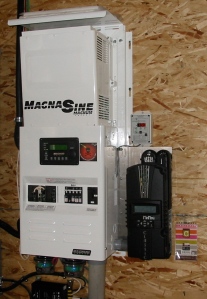Here's a link to one of RCinFL's technical explainations, which goes into far better technical detail then I could ever hope to give.
Hello all I'm looking to redesign my off-grid cabin with solar so I can run a window air conditioner from DC to AC looking for advice. Right now what I'm using is old lead acid Trojan batteries that are on their last leg I have 400 watts of solar 12 volt panels as well as zentrex 35 amp charge...

diysolarforum.com
Here are his details, cut and pasted. Although this review is concerning inverters, I'm sure that the same general conclusions could be applied to imported charge controllers as well.
Many of the high freq inverters are very low cost, and low quality. There are only a couple of good quality models.
As to U.S. split phase, many of Chinese inverters, either HF or LF are just poor design showing a poor understanding of split phase requirements.
Their designs select parts spec'd with little to no design margin. Battery input line caps have 63v rating for 48v inverter, HV DC filter caps and PV input caps are 500v rating, with max PV input voltage specs on inverter of 500vdc. There are very small value filter caps on HV DC node so there is a lot of 2x AC out freq ripple voltage on them which heats up electrolytic caps reducing their lifespan. It also gives them little to no surge capability. PV input caps are very low in capacitance so there will often be ripple getting through to PV panel loading which reduces panel maximum power point output current. AC connect relays are cheap water heater relays rated for resistive loads. On higher wattage inverter models they put two of these cheap 40A resistive load rated relays in parallel to handle higher AC current.
High no-load idle current is mostly the result of poor design, lacking the knowledge of how to minimize switching losses, and/or allowing more switching crossover tolerance slop to allow for random part substitutions in manufacturing.
HF split phase have two individual inverter circuits operating in series similar to 240/120 vac inverter-generators. Although could be a single inverter circuit, most HF inverters use an H-bridge PWM chopping sinewave generating output stage. This means their high voltage DC supply must be independent between the the two split phases with two separate PWM output stages.
Most of the Chinese HF all-in-one inverters do not have their PV inputs isolated from AC output. This means the PV panels wiring are riding on top of the inverter PWM high voltage DC polarity switching from the PWM AC output H-bridge. You must use double pole DC breakers to PV panels to disconnect both positive and negative lines to PV panels.
True bi-directional battery to HV DC converters are difficult to design and control. Many Chinese HF inverters do not attempt to do it. They just put a parallel buck converter circuit change-over to charge battery from HV DC node. This takes some switchover time which limits the functionality of many HF hybrid inverters. For example, they cannot do load shaving or load supplimenting by inverter with grid or generator AC input. When connected to AC input they only allow AC pass-through and battery charging from AC input. They cannot suppliment a generator with limited power output.
Many of the recent low freq inverters from China do not have the management/control of split phase grid neutral voltage imbalance and cannot be connected to grid neutral in a code complient install. They don't provide for split phase AC input grid neutral connection making them non-code complient.
With single center tapped output transformer low frequency inverters, there must be grid neutral management to prevent output transformer from trying to correct for grid L1-N to L2-N voltage imbalance that can cause high currents in output transformer. Lacking the safe guard to check for this, the low cost LF inverters cannot safely be connected to grid neutral.
Be careful of HF inverter surge claims. 2x surge capability for a couple of msecs is no surge capability. Single phase induction motors startup surge is 400 to 500 msecs long so any surge spec less than at least a half a second is pretty much useless.
Also be careful of believing specs. With All-in-One inverters there are many ways to stretch the true. For example a HF all-in-one inverter specs, "DC to AC conversion efficiency = 96%" and is only efficiency spec listed. Intent is to make you believe this is inverter battery to AC output efficiency. It is not.
It is PV DC input, when PV voltage is close to inverter's internal HV DC node so PV SCC boost is barely required to boost PV voltage up to HV DC node so its efficiency is very high, like 99%. Most of the 96% efficiency number is just the high voltage DC to sinewave PWM H-bridge switching loss and L-C output filter loss.
Battery to HV DC boost converter, which is about 94% efficient by itself, is not involved in this path. Optimum battery to AC out efficiency is about 93% which is about the same as LF inverters.
One manufacture finds a way to stretch the truth and all other manufacturers follow in order to be competitive. Most of the Chinese HF all-in-one inverters are just copies of the same basic circuit with individual manufacturer's effort put into pulling a few more pennies of cost out of bill of material. Build lot, to build lot, of a given inverter model will have different parts depending on what parts are available at the lowest cost.




